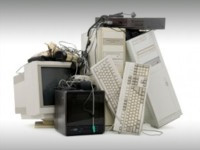Global E-Waste Crisis is Worsening
 The consumer electronics revolution of recent years, for all its benefits, has also yielded an environmental blight in the form of e-waste - obsolete electronics equipment whose toxic materials and sheer volume are placing a strain upon solid waste management systems worldwide.
The consumer electronics revolution of recent years, for all its benefits, has also yielded an environmental blight in the form of e-waste - obsolete electronics equipment whose toxic materials and sheer volume are placing a strain upon solid waste management systems worldwide.According to a new report from Pike Research, the e-waste crisis will worsen over the next several years until 2015, when volume will peak at 73 million metric tons. However, the firm forecasts that global volumes will decline in 2016 and beyond, as a number of key e-waste initiatives begin to turn the tide.
“Key weapons in the war against e-waste include government regulation, electronics industry initiatives, and consumer awareness,” says managing director Clint Wheelock. “On the positive side, the European Union has established a strong regulatory framework with its WEEE and RoHS directives, serving as an example for similar initiatives worldwide.
Many leading electronics manufacturers and service providers are also strong exemplars of what corporate social responsibility can achieve - in Pike Research’s analysis, this list of leading companies includes Cisco, Dell, HP, Motorola, Nokia, Research In Motion, Sprint Nextel, and Vodafone.”
However, adds Wheelock, significant challenges remain, the most notable of which is consumer behavior. “It’s too easy and relatively inexpensive to simply throw electronics away,” he says, “though we are seeing improvements in popular awareness.” In addition, there is no international coordination on e-waste regulation and, as a result, the electronics recycling supply chain is full of holes and open to widespread abuse.
Pike Research’s study, “Electronics Recycling and E-Waste Issues”, provides a comprehensive analysis of the global e-waste landscape. The report includes SWOT analysis for key sectors, analysis of consumer survey results, and forecasts for e-waste generation and processing volumes through 2025. An Executive Summary of the report is available for free download on the firm’s website.

